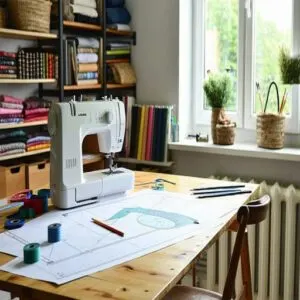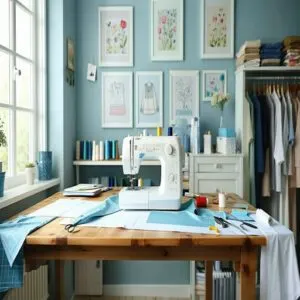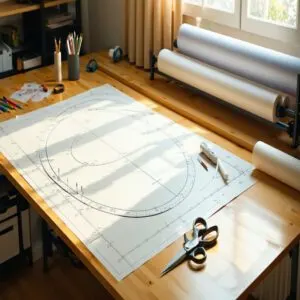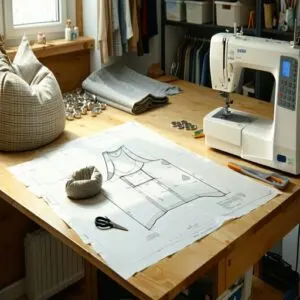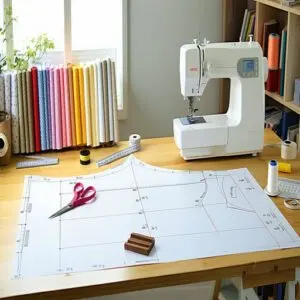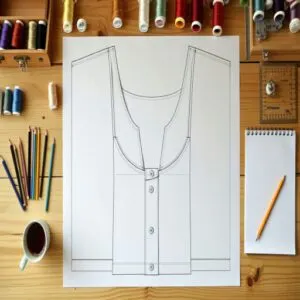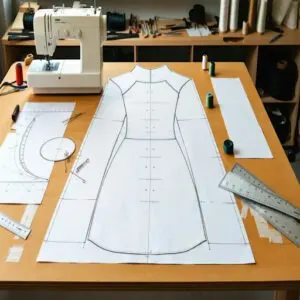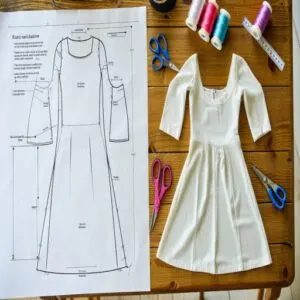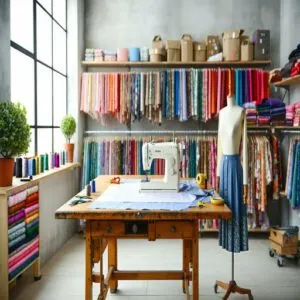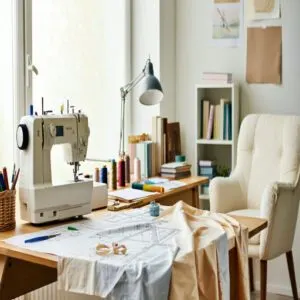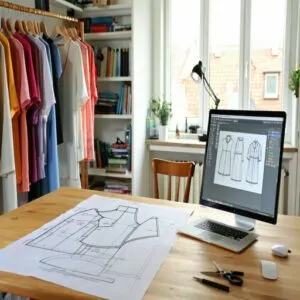This site is supported by our readers. We may earn a commission, at no cost to you, if you purchase through links.
 Looking for sewing pattern making help? Start with your tools—snag a measuring tape, ruler, pattern paper, and tracing wheel.
Looking for sewing pattern making help? Start with your tools—snag a measuring tape, ruler, pattern paper, and tracing wheel.
Accurate body measurements are the secret sauce here, so focus on spots like the bust, waist, and hips.
Feeling adventurous? Draft your pattern from scratch for ultimate customization, or trace a favorite garment for a quick win.
Don’t forget seam allowances (5/8 inch is standard) and use French curves for smooth, professional lines.
Keep your paper steady with pattern weights, and that trusty muslin fabric? It’s perfect for testing your masterpiece.
Ready for more tricks? Let’s talk creative fabric experiments next!
Table Of Contents
Key Takeaways
- Focus on accurate body measurements like bust, waist, and hips to ensure patterns fit properly.
- Use essential tools like French curves, pattern paper, and tracing wheels for precision in drafting patterns.
- Always test your patterns with muslin fabric to spot and fix any fit issues before using your final fabric.
- Add standard seam allowances (like 5/8 inch) and keep patterns steady with weights while cutting.
Sewing Pattern Basics
When you’re making sewing patterns, understanding the basics is like setting the foundation for a sturdy house—it’s essential.
Grab your measuring tape, ruler, and tracing tools, and let’s make sure you’re equipped to create patterns that actually fit!
Essential Tools and Measurements
Ever wondered why your sewing pattern making feels off? It’s all in the measuring techniques! Grab a good measuring tape and focus on key body measurements—bust, waist, hips.
Trust me, nailing those body proportions guarantees a smoother fit.
Pair it with core pattern making tools like rulers and sewing notions for precise pattern drafting every time.
Accurate measurements also depend on using the right measuring tape tools to facilitate consistency in your sewing projects.
Pattern Paper and Tracing Wheels
Choosing the right pattern paper matters—opt for durable types like tracing paper for accuracy.
Pair it with tracing wheels, your go-to for transferring designs smoothly, and keep the wheel sharp and rolling—no one wants jagged lines.
Use drafting pencils for clean adjustments.
Store patterns neatly to reuse them later; trust me, your future self will thank you.
Measuring Tape and Ruler
Mastering a measuring tape and ruler is like sharpening your sword for pattern making. They’re your sidekicks for precision!
- Wrap the tape snugly for accurate body measurements, like bust or waist.
- Double-check ruler calibration for straight lines.
- Use precision tools on pattern paper.
- Mark lightly for accurate marking.
- Handle tape carefully—stretching skews measurements!
Using the right sewing machine tools can make a significant difference in the quality of your work.
Perfect measurements = better garment construction!
Pattern Creation Methods
Creating patterns can feel like magic when you know the right methods to try.
Whether you’re sketching from scratch or tracing a favorite shirt, there’s a technique that’ll match your style and skills.
Drafting From Scratch
Drafting patterns from scratch gives you complete freedom with custom pattern making.
Start with precise body measurements and essential drafting tools like rulers and French curves.
Create basic pattern blocks, shaping garment silhouettes with darts or ease, and test with muslin fabric to perfect garment construction.
This pattern creation method guarantees a customized fit, perfect for unique designs, and utilizing pattern making tools can substantially enhance your drafting skills and overall sewing experience.
Tracing Existing Garments
Using tracing clothes for pattern making is a breeze.
Lay your garment flat, pin it to pattern paper, and trace around the edges for a custom pattern.
Don’t skip measurement accuracy—adjust as needed for the right fit.
This technique hones drafting skills while saving time.
Bonus tip: practice on simple garments like t-shirts to perfect pattern tracing.
Deconstructing Existing Garments
Taking apart clothes for pattern making isn’t as wild as it sounds—it’s all about patience and detail.
Start with garments you don’t mind sacrificing.
Carefully dissect them to understand garment construction techniques.
- Analyze the garment’s structure before cutting.
- Use a seam ripper for clean fabric dissection.
- Lay pieces flat, tracing clothes accurately.
- Mark seam allowances for pattern reverse success.
Modifying Commercial Patterns
Tired of starting from scratch?
Modifying commercial patterns is like playing fashion detective—grab a pre-made design and tweak it to suit your vision.
Pattern hacking lets you adjust necklines, add length, or mix styles effortlessly.
Fit adjustments? Easy with grading techniques!
Commercial alterations save time, and a little pattern drafting transforms “store-bought” into “made-for-you.”
Sewing pattern making just got personal!
Pattern Drafting Techniques
In the context of pattern drafting, tools like French curves and hip curves make shaping necklines and armholes a breeze.
Don’t forget to add a standard seam allowance (5/8 inch is a safe bet) and use pattern weights to keep everything steady while you work!
French Curves and Hip Curves
When you’re pattern drafting, French curves and hip curves are your secret weapons for smooth, professional lines.
These tools make body contouring and hip shaping a breeze.
Here’s how to use them:
- Align curves with your sketch.
- Trace for pattern smoothing.
- Blend seams naturally.
- Adjust for curve grading.
- Perfect armholes or necklines effortlessly.
The use of these tools allows for efficient and effective pattern smoothing, making the drafting process easier and more precise.
Pattern Weights and Scissors
For sewing pattern making, pattern weights keep your paper steady while cutting tools like fabric shears glide through cleanly.
Forget chasing paper as it slides everywhere—weights can be everyday items like washers or DIY beanbags.
Scissors? Invest in sharp ones strictly for fabric, as mixing paper and fabric dulls blades faster than leftovers you forgot in the fridge.
Understanding basic pattern making techniques is essential for creating accurate and functional sewing patterns.
Standard Seam Allowance
When working with seam allowances, always stick to standard seam allowance guidelines—typically 5/8 inch.
These pattern margins give you wiggle room for sewing tolerances and fabric shrinkage.
They also safeguard you from cutting errors.
Mark your sewing pattern symbols clearly to keep track of seam allowances and pattern ease.
It’s like leaving breadcrumbs to avoid getting lost mid-project, following standard guidelines for sewing tolerances.
Working Patterns and Blocks
Working patterns and blocks are the backbone of creating any garment, giving you a reliable guide for precise shaping and fit.
Think of them like the blueprint for your sewing masterpiece—get this right, and the rest becomes a lot easier, with precise shaping being the key to a successful garment.
Line Drawing and Development
Sketching the pattern’s blueprint is where the magic begins.
Grab your tools, focus on clean line sketching, and map out shapes with confidence.
Use rulers for edges, French curves for smooth shifts, and pencils for adjustments.
This pattern development stage is all about experimenting with design iteration and shape analysis—think of it as the skeleton of your creative curve creation!
Creating a Basic Block
Ready to build the foundation of pattern making? Start with basic blocks like bodice blocks, the core of great garment fitting.
With precise body measurements, pattern drafting transforms a blank sheet into a basic silhouette.
Draw rectangles, define curves with French curves, and add darts for shaping.
Master this step, and pattern design becomes your creative playground.
Understanding the bodice block drafting process is essential for creating well-fitting garments.
Modifying Existing Blocks
Once your basic block fits well, it’s time for pattern tweaks.
Want a snugger waistline or a looser sleeve? Simple adjustments, like seam modifications and dart shifts, can change the fit entirely.
Experiment with drafting variations, like raising a neckline or altering a hem length. These block alterations can transform your original pattern into multiple designs, saving time and fabric.
Creative Pattern Making
You’re in for some fun with creative pattern making—it’s all about experimenting with shapes, fabrics, and techniques to bring your unique ideas to life.
Grab some pattern paper, try bold designs, and don’t be afraid to cut, drape, and tweak until it feels just right!
Flat Pattern Cutting
Flat pattern cutting is like solving a fabric puzzle—precision is your best friend.
Start with pattern paper and trusted tools for creating clean, smooth shapes.
Here’s how to boost your garment construction skills:
- Use a French curve for neckline and armholes.
- Prioritize pattern precision—don’t skip seam allowances!
- Test cutting techniques on scrap fabric before slicing your favorite textile.
Draping and Manipulation
Start with fabric draping on a dress form to explore draped silhouettes and garment shaping.
Pin strategically but let gravity show the textile’s natural movement.
Experiment with folds, pleats, and dart manipulation for unique pattern alterations.
Don’t stress—fabric manipulation is trial and error.
Take photos to capture your wins (and fails!).
It’s pattern making with flair!
Experimenting With Fabrics
Playing with textiles can teach you so much.
Test your fabric selection by stretching, scrunching, or observing drape to catch surprises before cutting.
Explore weave analysis or fiber blending to see how fabrics react.
Yarn comparison is about thinking soft knits vs. crisp cotton.
Fabric manipulation is like a science experiment—tap into textile science for results that shape amazing patterns.
Sewing Pattern Tips and Mistakes
It’s easy to overlook small details when making patterns, but those tiny mistakes can lead to big sewing headaches.
Don’t worry—by keeping an eye out for common errors and practicing a few time-saving tricks, you’ll avoid the frustration and get closer to that perfect fit.
Common Mistakes to Avoid
Skipping the muslin? Big mistake.
Without testing, it’s like driving blindfolded—you’ll miss fit issues.
Watch out for incorrect measurements; sloppy math leads to disaster.
Poor fabric choice can ruin your masterpiece; muslin or inexpensive fabric is your testing ground.
Don’t skimp on seam allowances; insufficient seam space leaves no room for errors.
Careless cutting or inaccurate grading? They can derail your sewing pattern making faster than you can say “start over,” which is a result of poor fabric choice.
Making a Muslin and Checking Fit
Before committing to your final fabric, whip up a muslin using cheap muslin fabric.
It’s your test run for spotting fit issues and fine-tuning your sewing patterns.
Think of it like a dress rehearsal – tweak darts, adjust seams, and confirm comfort.
A little extra effort here saves future headaches.
Garment fitting isn’t glamorous, but trust me, nailing the fit transforms your pattern making into wearable perfection.
Advanced Pattern Making
When you’re ready to level up your pattern-making skills, advanced techniques like digital drafting and Adobe Illustrator will be your new best friends.
Don’t sweat it—these tools make creating and even selling your custom designs easier than you’d expect with digital drafting!
Digital Pattern Drafting
Let’s talk digital pattern making—it’s like upgrading to a sewing superpower.
With pattern software, you’ll draft patterns with precision, test virtual fitting, and fine-tune designs faster than ever.
Online tutorials make learning these digital tools doable, and drafting techniques stay sharp.
Just don’t skip backups—trust us, losing digital work feels worse than botching fabric!
Using Adobe Illustrator
You’ve got Illustrator ready? Perfect.
This powerhouse fashion design software makes digital pattern making a snap. Use vector graphics to sketch precise shapes, add seam allowances with ease, and edit curves like a pro.
Here’s how:
- Draw patterns using the Pen Tool for ultimate control.
- Edit with layers to keep adjustments neat.
- Save reusable templates to simplify your workflow.
Establishing an Online Presence
Building your online presence isn’t rocket science, but it’s where sewing businesses shine today.
Use social media to show your sewing pattern making process and online sewing courses.
Craft a killer website for sales and brand identity.
Here’s how:
| Platform | Focus |
|---|---|
| Short video tips | |
| Etsy | Digital sales |
| DIY sewing boards | |
| YouTube | Tutorials |
| Shopify | Ecommerce setup |
Pattern Making Software and Tools
If you’ve ever wished for a magic wand to create sewing patterns, pattern-making software and tools are the next best thing.
They help you craft precise designs without pulling your hair out over tricky measurements, from Adobe Textile Designer to trusty dress forms.
Adobe Textile Designer and PatternSmith
If you’re diving into digital drafting tools, Adobe Textile Designer and PatternSmith are fashion tech powerhouses.
Adobe’s graphic editing magic helps visualize patterns on 3D models, while PatternSmith optimizes fabric use with its nesting feature.
Both streamline sewing pattern making—whether you’re experimenting with textile design or creating precise clothing designs, these tools make pattern design effortless.
Mastering pattern making software is essential for achieving professional results in fashion design and textile creation.
Accumark 2D and CAD Software
If you’ve mastered Adobe Textile Designer, AccuMark 2D brings even more power to your pattern drafting.
This CAD Design software lets you create precision sewing patterns with ease, perfect for fashion design software pros.
From digital drafting to pattern simulation, it’s ideal for perfecting every detail.
Plus, its technical support makes conquering complex clothing design software a breeze.
For accurate results, utilizing AccuMark 2D software is essential for professional pattern making.
Dress Forms and Pattern Scissors
A dress form’s like your silent sewing buddy—it lets you see how your pattern works in real life.
Pair it with sharp fabric shears for clean cuts.
To level up:
- Use fabric shears, not regular scissors.
- Pin patterns on dress forms for accuracy.
- Try adjustable dress forms for versatility.
- Invest in quality tailoring tools.
- Keep blades sharp for smooth pattern cutting.
Understanding dress form pattern making is essential for creating well-fitted garments.
Finalizing and Selling Patterns
You’ve got your pattern perfected, so now it’s time to package it up like a pro and share it with the world.
With clear instructions, polished files, and the right tools, you’ll make your patterns irresistible to customers.
Creating Clear Instructions
Clear instructions can make or break your pattern.
Keep them simple, logical, and supportive—like a friend guiding you through.
Use plain language, numbered steps, and visuals where needed.
Avoid assumptions about what people "should know."
| Do’s | Don’ts |
|---|---|
| Number steps clearly | Use vague or complex language |
| Add diagrams or visuals | Overload with too much text |
| Test your instructions | Assume everyone interprets like you do |
Preparing Final Pattern Files
Now that your instructions are ready, let’s polish your pattern files.
Keep them organized and ready-to-share with these tips:
- Save files as PDFs for reliable sharing.
- Organize layers for easy editing.
- Use data compression to reduce file size.
- Back up files in digital storage.
- Add file security (password protect) for professional flair.
This set of tips is designed to help you manage your files effectively, ensuring they are not only easy to share but also secure and efficiently stored.
Utilizing Design Software and Online Platforms
Got your final patterns ready? It’s time to polish them with digital tools.
Sewing software like Adobe Illustrator or Seamly2D lets you tweak designs with precision.
Explore platform integration options on online marketplaces for selling digital sewing patterns.
Need guidance? Many sewing pattern courses include software tutorials to help you ace design optimization and reach buyers faster!
Frequently Asked Questions (FAQs)
How can I improve my pattern making?
Focus on nailing accurate measurements, experiment with cheap fabric for practice.
Don’t skip a muslin fit test, use tools like French curves and drafting software to refine details.
Stay curious, mistakes teach!
What are the 5 steps in pattern making?
It’s funny how precision can feel like chaos at first.
Measure accurately, sketch your design, draft the pattern on paper, add seam allowances and darts, then test it with a muslin.
Practice makes precision!
What are the three principles of pattern making?
Three key principles of pattern making are balance, ensuring the pattern hangs correctly, proportion, maintaining design harmony, and flow, making all pieces align smoothly.
Nail these, and your designs will look and fit perfectly!
How can I make my own pattern for free?
Think of it like tracing a treasure map—grab paper, a pencil, and your favorite shirt.
Trace its outline, tweak for fit, add seam allowances, and voilà!
Test with cheap fabric before sewing gold.
How do you choose the right fabric?
Pick fabric that complements the garment’s style and drape.
For instance, lightweight cotton works for shirts, while stretchy jersey suits form-fitting designs.
Always check the pattern’s recommendations and feel the fabric to match your vision.
What’s the best way to store patterns?
Keep patterns in labeled envelopes or ziplock bags, sorted by type in clear bins or binders.
For digital ones, back them up on cloud storage.
Bonus tip: Don’t forget to write notes for tricky adjustments!
How can you customize fit for children?
Get their exact measurements—kids grow fast, so don’t skip this.
Use adjustable waistlines, elastic, or snaps for flexibility.
Test with a muslin first to tweak fit.
Bonus tip: Avoid overly fitted designs—they need room to play!
How do you upcycle patterns creatively?
Upcycling patterns is like remixing a favorite song—add new details, combine elements, or reshape sections.
Turn old dress patterns into tops, mix skirt designs, or layer fabrics creatively to craft something fresh and unique.
What are tips for sewing stretchy fabrics?
Stretchy fabrics can be tricky, but use a ballpoint needle—it won’t snag.
Zigzag or stretch stitches are your best friends, and don’t pull the fabric too hard.
Let it glide naturally.
Relax—it’s forgiving!
Conclusion
Think of sewing pattern making as baking a recipe—it takes the right tools, measurements, and a bit of creative flair to get it just right.
Whether you draft from scratch, trace a favorite piece, or tweak a block, practice and patience are your best friends.
Add seam allowances, test with muslin, and own your mistakes—they’re the breadcrumbs to mastery.
With this sewing pattern making help, you’ll soon craft custom designs that fit like a glove.
Keep stitching!
- https://www.seamwork.com/articles/the-10-biggest-sewing-mistakes-you-can-make
- https://fairfitstudio.com/blog/patternmaking-101-how-do-i-start-making-my-own-patterns
- https://windowsreport.com/apparel-pattern-making-software/
- https://www.goldstartool.com/pattern-making-tools/
- https://www.theshapesoffabric.com/2018/02/28/dart-manipulation-basics/

